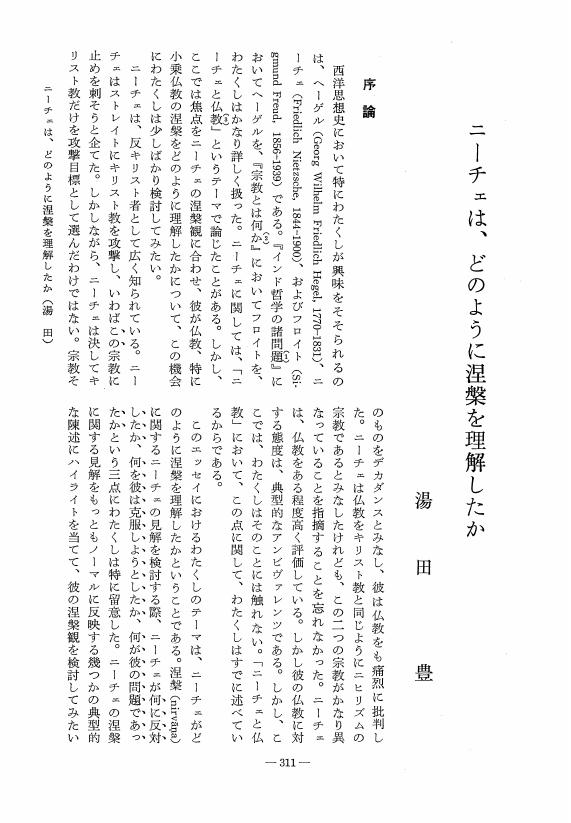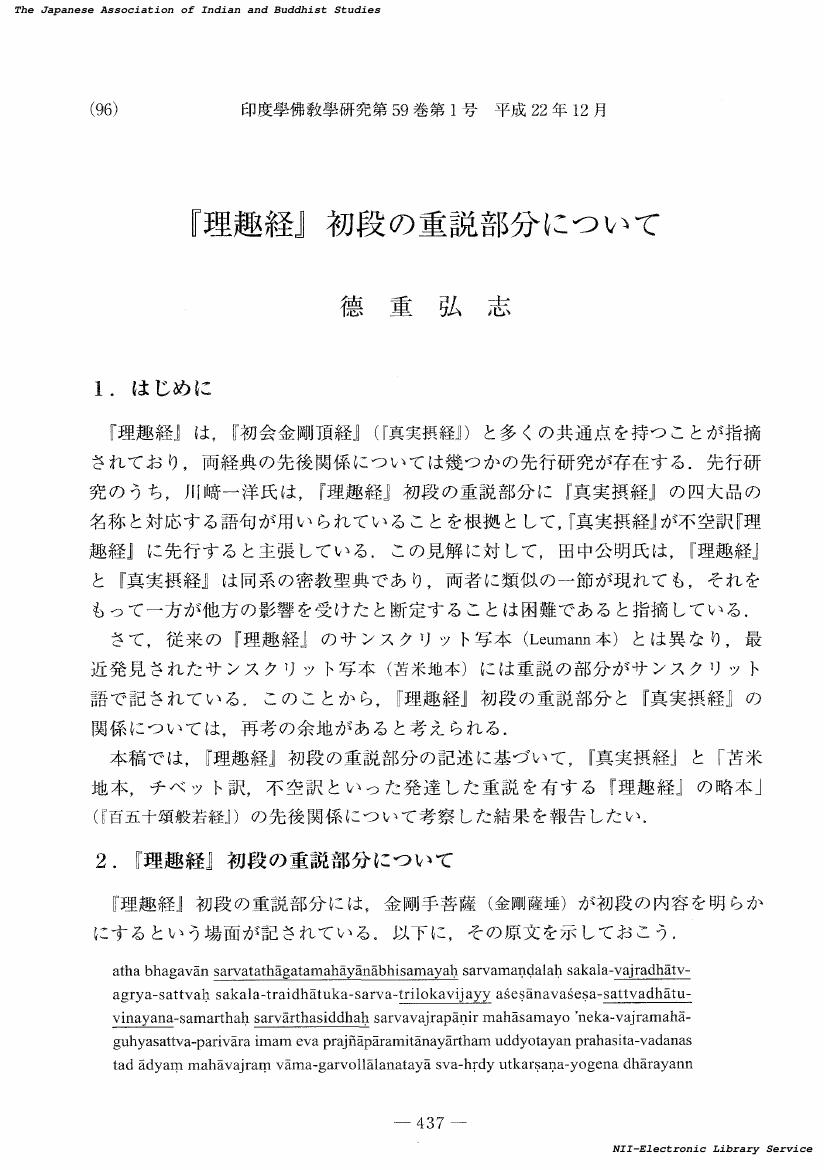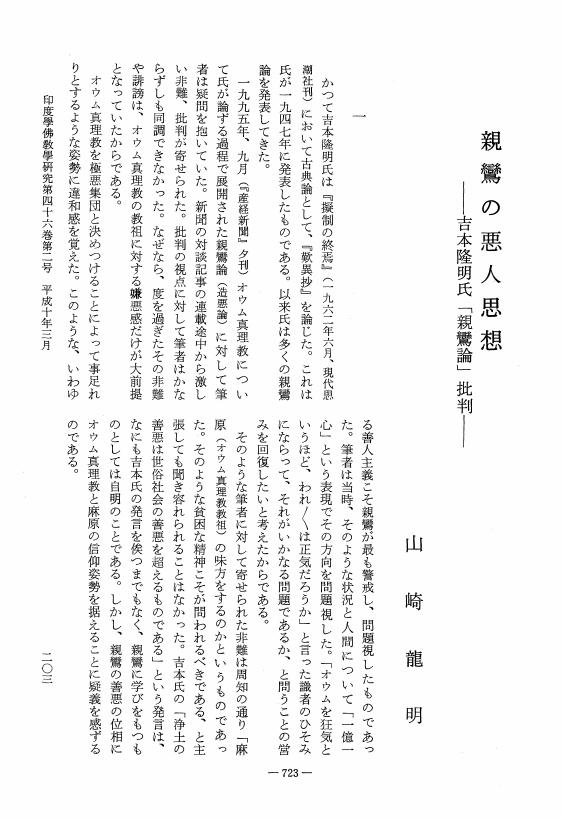1 0 0 0 OA 一遍上人の教化理念
- 著者
- 竹内 明
- 出版者
- Japanese Association of Indian and Buddhist Studies
- 雑誌
- 印度學佛教學研究 (ISSN:00194344)
- 巻号頁・発行日
- vol.19, no.1, pp.362-366, 1970-12-25 (Released:2010-03-09)
1 0 0 0 OA 中道思想と縁起説
- 著者
- 仲宗根 充修
- 出版者
- Japanese Association of Indian and Buddhist Studies
- 雑誌
- 印度學佛教學研究 (ISSN:00194344)
- 巻号頁・発行日
- vol.53, no.1, pp.389-387, 2004-12-20 (Released:2010-03-09)
- 参考文献数
- 1
1 0 0 0 OA 日本仏教と菩薩戒
- 著者
- 竹田 暢典
- 出版者
- Japanese Association of Indian and Buddhist Studies
- 雑誌
- 印度學佛教學研究 (ISSN:00194344)
- 巻号頁・発行日
- vol.33, no.1, pp.1-6, 1984-12-25 (Released:2010-03-09)
- 被引用文献数
- 1
1 0 0 0 OA ニーチェは、どのように涅槃木を理解したか
- 著者
- 湯田 豊
- 出版者
- Japanese Association of Indian and Buddhist Studies
- 雑誌
- 印度學佛教學研究 (ISSN:00194344)
- 巻号頁・発行日
- vol.34, no.1, pp.311-318, 1985-12-25 (Released:2010-03-09)
1 0 0 0 OA 『理趣経』初段の重説部分について
- 著者
- 徳重 弘志
- 出版者
- 日本印度学仏教学会
- 雑誌
- 印度學佛教學研究 (ISSN:00194344)
- 巻号頁・発行日
- vol.59, no.1, pp.437-434, 2010-12-20 (Released:2017-09-01)
1 0 0 0 OA 『説法明眼論』の引用典籍の特徴
- 著者
- 千葉 正
- 出版者
- Japanese Association of Indian and Buddhist Studies
- 雑誌
- 印度學佛教學研究 (ISSN:00194344)
- 巻号頁・発行日
- vol.52, no.2, pp.604-607, 2004-03-20 (Released:2010-03-09)
1 0 0 0 OA 『正法眼蔵』と本証妙修
- 著者
- 粟谷 良道
- 出版者
- Japanese Association of Indian and Buddhist Studies
- 雑誌
- 印度學佛教學研究 (ISSN:00194344)
- 巻号頁・発行日
- vol.43, no.2, pp.629-633, 1995-03-25 (Released:2010-03-09)
1 0 0 0 OA 律蔵における判定事例集(vinītaka)について
- 著者
- 李 薇
- 出版者
- 日本印度学仏教学会
- 雑誌
- 印度學佛教學研究 (ISSN:00194344)
- 巻号頁・発行日
- vol.67, no.2, pp.1018-1012, 2019-03-20 (Released:2019-09-20)
- 参考文献数
- 5
Six Vinayapiṭakas have come down to us: the Pāli Vinaya, Dharmaguptaka-vinaya (Sifen lü, 四分律), Mahīśāsaka-vinaya (Wufenlü, 五分律), Mahāsāṃghika-vinaya (Mohesengqi lü, 摩訶僧祇律), Sarvāstivāda-vinaya (Shisong lü, 十誦律) and Mūlasarvāstivāda-vinaya (根本説一切有部律).The Pāli Vinaya (Buddhist monastic law codes) is comprised of three main aspects: 1) the Vibhaṅga (analyses of the rules in the pāṭimokkhasutta), 2) the Khandhaka (corporate law or transactions of the saṅgha and so on), and 3) the Parivāra (a brief review of the Vibhaṅga and Khandhaka).The Vibhaṅgas of the four pārājika offenses of the Pāli Vinaya includes four sections, 1) nidāna (episodes that caused the rules to be made, 因縁譚), 2) sikkhāpada (the rules, 学処), 3) padabhājana (the analyses section of the sikkhāpada and offenses, 条文解釈), 4) vinītaka (the case-law pertaining to those rules, 判定事例集).In this study, I examine the vinītaka (判定事例集) of the six extant Vinayapiṭakas. The vinītaka is a part of the Vibhaṅgas in the Pāli Vinaya and found in the Khandhaka or Parivāra in the five Chinese Vinayapiṭakas. In this paper, I notice one characteristic of vinītaka: that the episode of the nidāna reappears as a brief statement in the vinītaka. This characteristic is found in the vinītaka of the four pārājika offenses in the Pāli Vinaya, and the first and fourth pārājika offenses in the Dharmaguptaka-vinaya, and the first pārājika offence in the Mahīśāsaka- and Sarvāstivāda-vinayas, but not found in the Mahāsāṃghika- and Mūlasarvāstivāda-vinayas.
1 0 0 0 OA 律文献からみるサンガの飢饉への対応
- 著者
- 井上 綾瀬
- 出版者
- 日本印度学仏教学会
- 雑誌
- 印度學佛教學研究 (ISSN:00194344)
- 巻号頁・発行日
- vol.69, no.2, pp.907-902, 2021-03-25 (Released:2021-09-06)
- 参考文献数
- 10
The vinayas allow special cases of “cooking and preserving food”, “utilizing leftover food”, and “collecting fruits” in case of famine. The famine exception does not apply when the famine is over. Even bhikkhu can work in times of famine in order to support their lives, according to the Vinayas. In the event of famine, the rules loosen. It was generally accepted in ancient India that there was a difference between normal and emergency times. It is common in the Vinayas and Dharma literature that, in the event of an emergency, bhikkhus or brahmins may take on the activities of someone with a different social status, while keeping their status as bhikkhu or brahmin, respectively. It can be said that the Buddhist sangha had the same character as the broader Indian society in that avoiding poverty is more important in an emergency than protecting the bhikkhu’s normally expected means of life.
1 0 0 0 OA 鈴木大拙における禅仏教の論理と民族主義
- 著者
- 元 永常
- 出版者
- 日本印度学仏教学会
- 雑誌
- 印度學佛教學研究 (ISSN:00194344)
- 巻号頁・発行日
- vol.57, no.2, pp.1129-1124, 2009-03-20 (Released:2017-09-01)
1 0 0 0 OA 「本質」と「疎所縁縁」 ――初期唯識思想と独我論――
- 著者
- 源 重浩
- 出版者
- 日本印度学仏教学会
- 雑誌
- 印度學佛教學研究 (ISSN:00194344)
- 巻号頁・発行日
- vol.60, no.1, pp.455-450, 2011-12-20 (Released:2017-09-01)
1 0 0 0 OA 親鸞の悪人思想 -吉本隆明氏「親鸞論」批判-
- 著者
- 山崎 龍明
- 出版者
- Japanese Association of Indian and Buddhist Studies
- 雑誌
- 印度學佛教學研究 (ISSN:00194344)
- 巻号頁・発行日
- vol.46, no.2, pp.723-730, 1998-03-20 (Released:2010-03-09)
1 0 0 0 OA 山伏の思想
- 著者
- 由木 義文
- 出版者
- Japanese Association of Indian and Buddhist Studies
- 雑誌
- 印度學佛教學研究 (ISSN:00194344)
- 巻号頁・発行日
- vol.32, no.1, pp.385-389, 1983-12-25 (Released:2010-03-09)
1 0 0 0 OA 叙事詩Mahabharataに見られる天女ウルヴァシー像
- 著者
- 石原 美里
- 出版者
- Japanese Association of Indian and Buddhist Studies
- 雑誌
- 印度學佛教學研究 (ISSN:00194344)
- 巻号頁・発行日
- vol.58, no.3, pp.1144-1148, 2010-03-25 (Released:2017-09-01)
Mahabharata(Mbh)のプーナの批判校訂版(C.ed.)では,天女であるUrvasiとArjunaに関する一説話(U-A説話)が省略されている.本研究ではその説話成立の背景に関しさらに深い考察を加え,そこに浮かび上がる天女Urvasi像を解明することを主眼とする.まずC.ed.において,UrvasiはU-A説話以外に明確な人格を持った物語の主役としてMbhの表面に現れることはない.その点に関してだけでもU-A説話は特に独自性を持つ説話であると位置付けられる.また,Urvasi以外にも天女が登場する説話は数多く存在するが,それらは概ねステレオタイプ化された一定のモチーフの発展形と言える.ところが,U-A説話はそれらの天女関連説話とは大きく内容を異にする.主な相違点は二つ,Urvasiが自分の意志で積極的に相手を誘惑するという点と,誘惑を拒まれた為に激怒して相手を呪うという点である.唯一このモチーフと類似する説話がBrahmavaivarta Puranaに収められている.Brahmavaivarta Puranaは最新層に属するプラーナであり,そのモチーフの類似性からU-A説話の創作された時代が叙事詩時代よりも,プラーナ最新層時代により近いという可能性が指摘されうる.ゆえに,U-A説話に見られる天女Urvasi像は,古来の伝統的な天女像ではなく,非常に新しい時代における天女像を反映したものであると考える事が出来る.また,U-A説話が創作された時点ではすでに,ArjunaがUrvasiの夫,Pururavas王を祖先とする系譜に属するという暗黙の了解がなされている.しかしMbhが現在の形に整う以前の古い時代には,Pururavas王を祖先とするPaurava一族はKaurava一族とは全く別系統のものであった可能性がある.つまり,Pandava五王子の系譜の正統性を高めようと目論んだある人物が,ある時点においてPururavasをその祖先として位置付け,Paurava=Kauravaという構図をMbhの中に埋め込んだと推測できるのである.そのような側面からも,U-A説話はMbhがほぼ現在の形に整えられた後に付加された,かなり新しい時代の挿入部分であるということが言えよう.
1 0 0 0 OA 『サーダナ・マーラー』におけるマーリーチーの成就法
- 著者
- 園田 沙弥佳
- 出版者
- 日本印度学仏教学会
- 雑誌
- 印度學佛教學研究 (ISSN:00194344)
- 巻号頁・発行日
- vol.68, no.1, pp.361-356, 2019-12-20 (Released:2020-09-10)
- 参考文献数
- 15
This presentation concerns Sādhanamālā (SM) 134, a meditation on the Mārīcī of three faces and eight arms (an image seen on extant art objects). The traits of the sādhana of SM 134 are elucidated via an understanding of its structural components.Among the Buddhist goddesses of the Pāla Empire (8th–12th century CE), works depicting Mārīcī are said to have been second in number only to those of the goddess Tārā, and Mārīcī worship was especially widespread in India. Sixteen types of Mārīcī sādhana are recorded in the SM, with Mārīcī displaying variously one face and two arms, three faces and eight arms, five faces and ten arms, six faces and twelve arms, or three faces and sixteen arms.In SM 134, in the preparatory stage for meditation, the concrete description of the figure of the goddess is characteristic. The reason is not clear, but in SM 142, in the preparatory stage for meditation (similar to SM 134) is the phrase “depict images [paṭa], etc. of the figure of the holy mother [Mārīcī]” (paṭādigatamūrrtiṃ bhagavatīm avatārrya); therefore, it may be that the concrete figure of Mārīcī spoken of in the preparatory stage of SM 134 is suggesting not only a mediation, but also the creation of actual objects depicting the goddess. From the fact that numerous holy images of Mārīcī have been confirmed in India, we surmise that in addition to mediation, emphasis was also placed on the mechanism of gaining blessings by the pious act of creating actual art objects.
1 0 0 0 親鸞から西田幾多郎へ・〈一人の思想〉再論
- 著者
- 津田 眞一
- 出版者
- 日本印度学仏教学会
- 雑誌
- 印度學佛教學研究 (ISSN:00194344)
- 巻号頁・発行日
- vol.49, no.2, pp.559-565, 2001
1 0 0 0 親鸞における阿弥陀仏の絶対的自己否定 -西田哲学を契機として-
- 著者
- 武田 龍精
- 出版者
- 日本印度学仏教学会
- 雑誌
- 印度學佛教學研究 (ISSN:00194344)
- 巻号頁・発行日
- vol.29, no.2, pp.491-496, 1981
- 著者
- 岡田 文弘
- 出版者
- 日本印度学仏教学会
- 雑誌
- 印度學佛教學研究 (ISSN:00194344)
- 巻号頁・発行日
- vol.70, no.1, pp.253-258, 2021-12
1 0 0 0 OA 道〓の戒律観と大仏建立
- 著者
- 直林 不退
- 出版者
- Japanese Association of Indian and Buddhist Studies
- 雑誌
- 印度學佛教學研究 (ISSN:00194344)
- 巻号頁・発行日
- vol.50, no.2, pp.538-541, 2002-03-20 (Released:2010-03-09)
1 0 0 0 源翁心昭と山林料〓
- 著者
- 石川 力山
- 出版者
- 日本印度学仏教学会
- 雑誌
- 印度學佛教學研究 (ISSN:00194344)
- 巻号頁・発行日
- vol.32, no.2, pp.597-602, 1984











